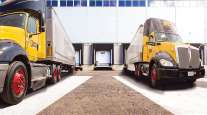FedEx Reducing Costs to Increase Its Profits
This story appears in the Oct. 15 print edition of Transport Topics.
FedEx Corp. last week aimed to improve profits by $1.7 billion over the next three fiscal years, almost all from cutting costs and streamlining operations at the Express unit.
FedEx disclosed the profit target, which represents more than a 50% increase, during an Oct. 9 investor meeting in Memphis, Tenn.
More than 90% of the savings are projected at the Express unit, where profit growth sagged as customers shifted to lower-cost and slower shipments to save money. The rest of the savings would be from the FedEx Services unit, which includes office and copying services.
“We are confident we will deliver the performance to ensure the near- and long-term success of FedEx,” CEO Frederick Smith said. “We believe we can do this, even in low-growth environments for global trade and within the major economies.”
“The key is striking the right balance between volume growth and yield improvements,” Smith said, adding that cost reductions are “essential to achieve our financial goals.”
The company’s presentation didn’t specify additional profit improvement at FedEx Freight, which in the 2012 fiscal year ended May 31, posted a $162 million profit, before interest and taxes, reversing a loss of $175 million in the prior fiscal year. That $337 million turnaround was achieved after integration of its regional and long-distance services and creation of a two-tiered priority and economy less-than-truckload service.
During the 2012 fiscal year, FedEx Express profit inched up just 2% to $1.26 billion as the unit’s operating ratio remained above 95.0. FedEx’s Ground unit, on the other hand, raised profit 25% to $1.76 billion and posted an operating ratio of 81.6.
“We are taking strong steps to improve profit margins,” FedEx Express President Dave Bronczek said on Oct. 10, disclosing details about the plan to boost his unit’s profits by a total of $1.55 billion by the end of the 2016 fiscal year.
He said $400 million would come from a buyout program, without specifying how many people would leave the company. Details will be announced sometime after Dec. 1, Bronczek said.
That amount represents a reduction of 4.1% from the $9.57 billion in salaries, wages and benefits in the 2012 fiscal year.
Bronczek also identified savings of $350 million each in the domestic and international operations and $300 million more from fleet modernization, moves expected to lower fuel costs by 20% to 30%.
The remaining $150 million will come from price increases, he said.
“The base profitability at Express is eroding, thanks to the ongoing trade-down effect,” Chris Ceraso of Credit Suisse said in an investor note.
“Mr. Smith does recognize that Express needs to be smaller,” Ceraso said in his report, “but he acknowledged that it is a very big ship that cannot turn on a dime.”
FedEx pledged to take advantage of shippers’ moves to reduce costs by building up its business that handles ocean freight, some of which is diverted from airfreight by customers to take advantage of lower marine shipment costs.
The effect on profitability from the planned $150 million in savings at the Services unit wasn’t clear because that unit’s earnings aren’t disclosed.
A “significant” portion of the overall improvement will be achieved in the 2015 fiscal year, FedEx’s statement said, without specifying an amount. Its 2013 fiscal year began on June 1.
During the investor meeting on Oct. 10, FedEx Freight President William Logue said, “We are positioned for further improvement” over fiscal first-quarter profit of $90 million, and he stated the goal of again moving profit margins above 10%.
Logue also said the freight unit is testing tractors powered by liquefied natural gas, with equipment entering service later this month to run at least 1,000 miles per day.
FedEx also announced that David Rebholz, president and CEO of FedEx Ground, will retire, effective May 31, 2013. A successor will be chosen later.
FedEx also reiterated its earlier profit outlook of $6.20 to $6.60 per share for the 2013 fiscal year, Analyst reports estimated that the $1.7 billion in profit improvement would boost earnings per share by at least 46%.
Smith said the company plans to increase its dividend in the future, also without saying by how much. The dividend now stands at 56 cents per share annually.




